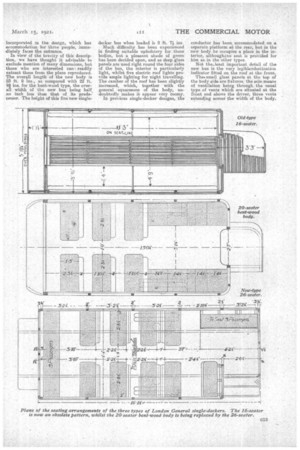SINGLE-DECK BUS SEATING.
Page 16

Page 17

If you've noticed an error in this article please click here to report it so we can fix it.
A New Design of Vehicle for the Illndon Streets, to Seat 26 Passengers.
being 11 ft. 3 ins., the width of the seats being 1 ft. 4 ins. BEARING IN mind that the London General Omnibus Co. is the largest individual concern operating motor buses in the world, it is only to be expected that one might look to them for a lead in the matter of motorbus improvements, particularly as regards body design, which, of course, allows far more scope for the displayof original ideas than does the mechanical side of omnibus construction.
The company are out to provide the travelling public with the best possible conveyance, due consideration naturally being given to efficient maintenance and operation. Within the last few days the L.G.O. Co. have put on the road a new type of single-decker which possesses several original features in body design. This is the third individual design of single-decker which has made its appearance on the Loi-idon streets within the laet few years, and for the purpose. of enabling our readers to make a comparison between these_ types, we reproduce. on the next page a plan of each body. This comparison will also afford an indication of the trend of single-deck bus body design, which would appear to be in the direction of increased seating capacity, combined with lightness of construction.
The original single-decker bad a seating capacity for 16 passengers, and the later. types are the direct result of experience gained from the use of this type. In this body, two longitudinal seats ran the whole length of the body sides and each had accommodation for eight passengers, the length of the seating line
.
Then followed what is termed the "bent-wood body," which, unlike the former type, has rounded sides. Practically all of the single-deckers now on
service are of this type, the former design having become obsolete. In this design, three sets of seats are disposed transversely in the body towards the front, each being 2 ft. 8 ins_ wide and having accommodation for two passengers, whilst a longitudinal seat on
either side, 5 ft. 5 ins, long, is disposed between the back of these transverse seats and the end of the body, each seating four passengers. This body, therefore, has a seating capacity for 20 passengers, and, although it possesses advantages over its prototype, it was found that the inswept body sides cramped the legs of the people sitting on the inside of the transverse seats. In each of these bodies, the Scotland Yard authorities permitted five people to stand, but this was not a particularly satisfactory arrangement, for it subjected those sitting to discomfort, as well as adding to the difficulty of collection of fares by the conductor.
In the latest type of body which has a seating capacity for 26 passengers, the arrangement of seats has undergone radical alterations. Working from the front end of the bus, it will be seen, from the plan of this body, that a seat runs transversely across the body immediately behind the driver's seat, so that five passengers with their backs to the driver can he accommodated. Then come three transverse seats facing forward on either side to seat two people, whilst a fourth set of similar seats faces in the opposite direction, the baeks of this pair being secured to the backs of the third pair of seats by hand grips. The reason for backing these seats to one another is to avoid the discomfort to passengers which results from the intrusion of the wheel paddle box into the interior of the body. On the near-side another transverse seat for two passengers faces for, ward, whilst the only longitudinal seat
incorporated m the design, which has accommodation for three people, immediately faces the entrance.
In view of the brevity of this description, we have thought it advisable to exclude mention of many dimensions, but those who are interested canreadily extract these from the plans reproduced. The overall length of the new body is 23 ft. 9 ins., as compared with 22 ft. 91. ins, for the bent-wood type, the overall width of the new bus being half, an inch less than that of its predecessor. The height of this fine new single
decker bus when loaded is 9 ft. 7.L. ins.
Much difficulty has been experienced in finding suitable upholstery for these bodies, but a pleasant shade of green has been decided upon, and as deep glass panels are used right round the four sidesof the bus, the interior is particularly light, whilst five electric roof lights provide ample lighting for night travelling. The camber of the roof has been slightly increased, which, together with the general scivareness of the body, undoubtedly makes it appear very roomy.
In previous single-decker designs, the conductor has been accommodated on a separate platform.at the rear, but in the new body he occupies a place in the interior, altboughtno seat is provided for him as in the other types.
Not the„least important detail of the new bus is the very legibletdestination indicator fitted on the roof at the front.
The.small glass panels at the top of the body side are fixtures,' the sole mews of. ventilation being through the usual type of vents which are situated at the front end above the driver, three vents extending across the width of the body.
































